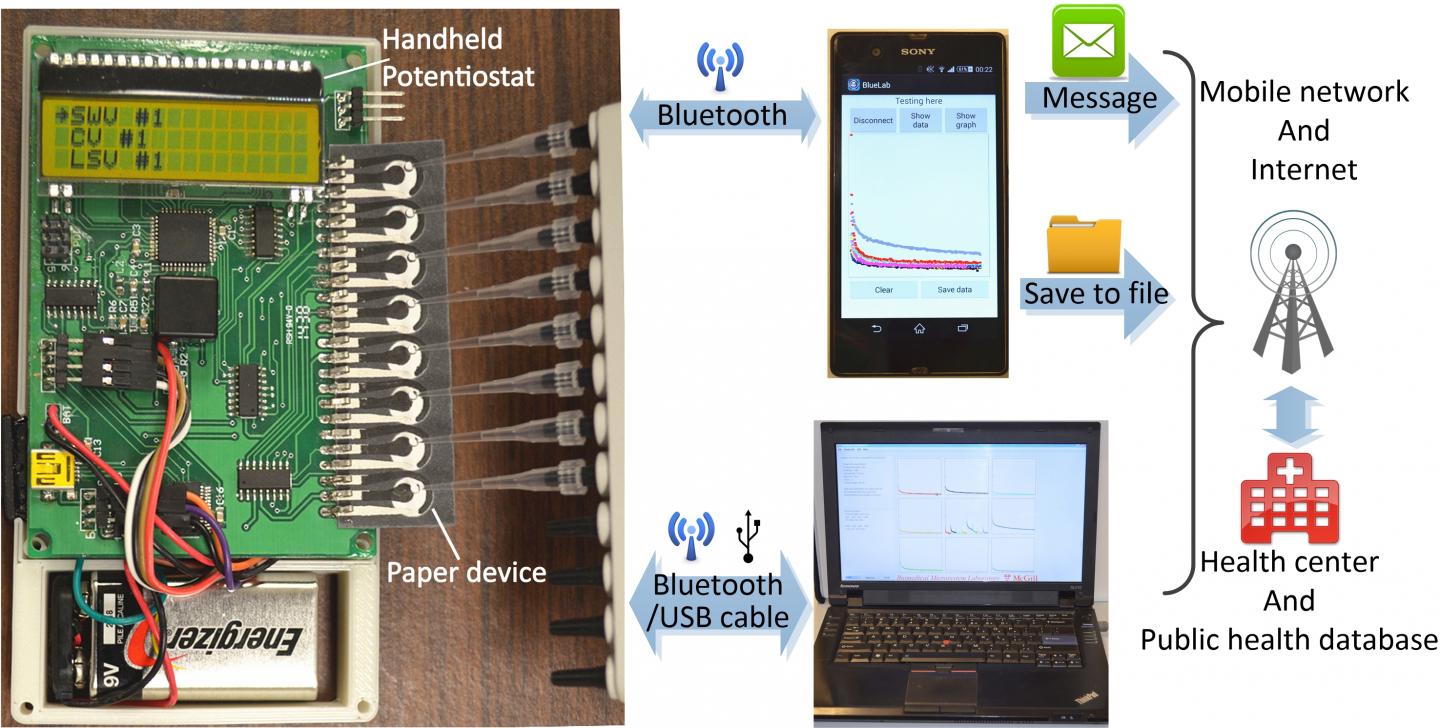On-the-Go Microfluidics Device May Provide Better Diagnostics of HIV/HCV
By LabMedica International staff writers
Posted on 21 Apr 2016
Researchers have created the first paper-based electrochemical immunosensing platform for rapid, inexpensive, point-of-care (POC) diagnosis of human immunodeficiency virus (HIV) and Hepatitis C virus (HCV) co-infections with broader multiplexing range and higher sensitivity than currently available antibody tests.Posted on 21 Apr 2016
An estimated one-third of people with HIV/AIDS are co-infected with HCV. While rapid POC tests are available, they tend not to be affordable or accurately quantify marker concentrations, which help determine stage of infection. The new portable platform, developed by researchers at McGill University (Montreal, QC, Canada) for diagnosing HIV/HCV co-infection within serum samples, includes an electrochemical microfluidic paper-based immunosensor array (E-μPIA) and has multiplexing ELISA and telemedicine capabilities.

Image: A depiction of the novel diagnostic platform that may soon enable low-cost, POC diagnosis of HIV & HCV co-infections within serum samples: a portable, paper-based microfluidic platform with multiplexing and telemedicine capabilities (Photo courtesy of C. Zhao, McGill University).
"Our experimental setup consists of a paper device with 8 electrochemical biosensors—for handy, one-time, disposable use—and a custom-made, handheld electrochemical reader, or potentiostat, to keep costs as low as possible," explained Prof. Xinyu Liu, "It enables 8 [simultaneous tests]: 4 for HIV antibodies and 4 for HCV antibodies," which makes the test broader than existing HIV and HCV point-of-care tests.
When assessing sensitivity with spiked mouse serum samples, the device could detect HIV and HCV antibodies at 300 pg/mL and 750 pg/mL, respectively – values lower than available antibody tests.
To run a test, the paper device is simply inserted into a slot on the potentiostat, and microliter drops of serum sample and reagents are added to each biosensor. Pressing a button triggers the electrochemical measurements. The device is compatible with internet-based and mobile network-based e-health systems. Data from the 8 tests can be directly displayed on an LCD screen of the potentiostat or transmitted to a smartphone or personal computer and then to a remote site—a centralized laboratory or hospital—for diagnoses.
The researchers tested for potential cross-reaction between the HIV and HCV antibody tests and found no significant interference, demonstrating “that our diagnostic platform shows great potential for diagnosing HIV/HCV co-infections in real patient samples," said Prof. Liu.
The main advantage offered is the ability to run 8 tests for HIV and HCV in parallel within 20 minutes with high accuracy, sensitivity, and specificity. Beyond this, the "handheld multiplexing potentiostat makes the entire electrochemical platform portable and significantly improves its adaptability to POC applications," explained Prof. Liu. The next step is to continue fine-tuning for practical use: "We'll explore the stability of the paper device during long-term storage, and then begin real patient sample testing in Canada and Kenya," he added.
Given the wide applicability of electrochemical detection to many types of biomolecules, the platform "can be readily extended to the detection of other disease markers such as proteins, metabolites, ions, and nucleic acids," added Prof. Liu, "Our long-term goal is to further extend the functionality of this diagnostic platform."
The study presenting the device design and testing, by Zhao C and Liu X, was published April 12, 2016, in the American Institute of Physics’ journal Biomicrofluidics.
Related Links:
McGill University













